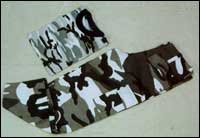Home > News > Report
Army looks to hide its jawans better
Josy Joseph in New Delhi |
February 25, 2004 09:03 IST
For Indian soldiers their uniform has always been a troubling partner.
The camouflage they wear while taking on terrorists or patrolling troubled borders doesn't let them breath properly. Also, the disruptive pattern on the combat uniform does not always help them merge with the surroundings.
"The disruptive pattern is not standardised and it sometimes gives away the soldier's location," says an army officer.
So the army is now working towards introducing a better breathing camouflage with a uniform pattern.
 But a complete overhaul of the camouflage is not happening immediately, officials say.
But a complete overhaul of the camouflage is not happening immediately, officials say.
An army spokesman says a uniform committee headed by the adjutant general of the army will meet in May to consider the patterns used by several countries.
The committee will also address complaints about lack of a standard in the disruptive patterns around the country.
"We will look at both fabric and patterns," says the officer.
The committee's decision will be implemented over a period of time, the officer says.
Numerous private players, including some of the leading mills of the country, now produce the camouflage uniforms, which were originally sourced from ordnance depots.
All the officers buy their camouflage from the open market because they are not provided any uniforms or boots from the military. They are paid Rs 7,000 every seven years for this purpose.
The non-officers get two pairs of uniforms each for a lifecycle, which, for some, is some 36 months.
But for an infantry soldier operating in the valley a camouflage wears out in a few months, after which he scouts the open market.
Several soldiers buy from open market even otherwise because the officially issued camouflage is "not smart", says the officer.
"It is a massive industry where numerous private players are involved. Each one has its own designs and patterns," he says.
"Today no producer knows what is the percentage of dust colour or green in a camouflage. None of them stick to the standards specified by the army after scientific studies. So a soldier in the desert might end up buying a camouflage that is meant for the forests of Kashmir," the officer adds.
The officer says the committee will look into the wear and tear of uniforms of soldiers in each terrain and operation, "because an infantry soldier's uniform will tear out before that of an armoured soldier's."
Commanders who met last October for their biannual consultations had also suggested a change in the army's winter uniform. The thick khaki angora shirts don't gel with the olive green trousers, some commanders point out.
However, any immediate change to the everyday olive green uniform is ruled out. Media reports in this regard were wrong, says the spokesman.
The olive green has been the army's standard uniform since World War II. The British introduced it and India retained it after Independence; the Pakistan army adopted a shade of khaki.
In fact the Indian Air Force and navy also retained most of the British uniforms. The Royal Crown insignias were replaced by the Ashoka Chakra and other appropriate symbols after independence. The IAF changed from khaki to sky blue shirt/navy blue trousers in 1990.
Changing the olive green will be a massive and expensive logistical exercise, says the officer. The army has over 40,000 officers and almost a million soldiers. Special allowances, running into a few thousand rupees for officers, are given every few years for buying uniforms.
"The olive green will remain our standard fare for now. What we are looking at is improving the combat fatigues and standardising the patterns," the officer told rediff.com
Ever since Admiral Madhvendra Singh took over as navy chief, there have been attempts to standardise the uniform fabric as well as introduce a new uniform.
However, the order declaring a specific fabric produced by a leading private mill as the standard threw up much speculation among the navy circles. "It was perfectly understandable because when you specify a particular fabric of a company you are automatically giving that company business that runs into numerous crores of rupees," says a navy officer.